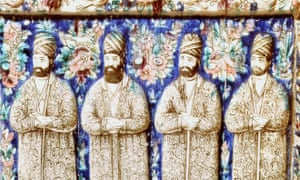When I studied Arabic in Damascus during the summer of 1999, my fellow students would often tell me I was going to hell. My crime? I was a bad Muslim for trimming
my beard. While many of the guys at this all-male institution had big, bushy beards, mine was more like designer stubble.
When I asked them why they didn’t shave, the majority would talk about imitating the prophet Muhammad. Many were also attempting to be as “manly” as possible. Mostly white western converts, they seemed to identify beards with
Islam.
Such is the panic about “Muslim” beards in some quarters that last October Swedish police were called out to investigate an innocuous group of hipsters known as the
Bearded Villains. Apparently a member of the public thought their black and white flag was the emblem of Islamic State.
The association between beards and Islam goes right back to Muhammad himself, who is said to have sported a beard, although the Qur’an says nothing about facial hair specifically. From the beginning, faith was intertwined with rigid notions of masculinity: Muhammad’s disciple Ibn Abbas reported that the prophet “cursed those men who assume the manners of women and those women who assume those of men”. For men, the beard was said to be a part of the “fitrah” – the natural order.
Even today, those who seek to uphold a political form of Islam find it easier to do so by strictly policing gender and sexuality. Boys should be boys, in their minds, and one way to make sure of that is to make them grow beards.
This attitude has created a great deal of pain among those who do not fit in, not least
transgender Muslims. But it has not gone unopposed, even among the devout. South Asia’s
antinomian mystics are probably the biggest challenge to this rigid world view. They often wear women’s clothing and jewellery, have big long beards and dance at the shrines of their Sufi masters. They state that they are the brides of God and this is their submission to God. Many identify as heterosexual. This certainly complicates any ideal of bearded Islamic masculinity.
Beyond the Muslim world, the link between hairiness and manliness has also been turned on its head. Even before urban hipsters fell for the lumberjack look, queer culture was embracing
“bears” – large, rugged men with hirsute chests and bushy beards. In another blow to the stereotype, last Christmas beard-owners were widely
encouraged to decorate them with oil and glitter. If you needed help, you could watch a helpful video from two men known as the Gay Beards.
I can’t help but think that those who seek rigid masculine and feminine portrayals of the Muslim man and woman must be extremely frustrated. However the beard started out, it has now grown into something very different.
Since you’re here …
… we have a small favour to ask. More people are reading the Guardian than ever but advertising revenues across the media are falling fast. And unlike many news organisations, we haven’t put up a paywall – we want to keep our journalism as open as we can. So you can see why we need to ask for your help. The Guardian’s independent, investigative journalism takes a lot of time, money and hard work to produce. But we do it because we believe our perspective matters – because it might well be your perspective, too.
I appreciate there not being a paywall: it is more democratic for the media to be available for all and not a commodity to be purchased by a few. I’m happy to make a contribution so others with less means still have access to information.Thomasine F-R.

